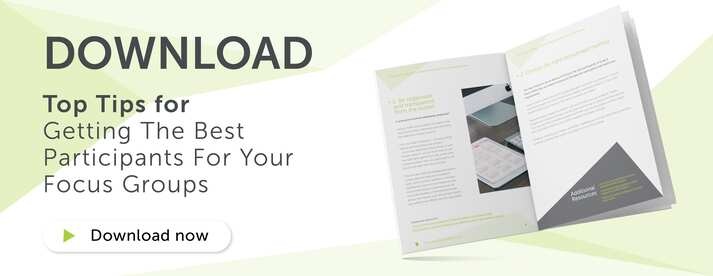
Why you should always carry out a feasibility test
Before starting any type of market research recruitment, you should always carry out a thorough feasibility test so you can get a clear idea of just how achievable your research is. Done right, assessing project feasibility will give you the solid foundations on which to build a successful qualitative market research project so you can unlock the insights you need to make informed decisions.
Basically, assessing your project's feasibility should help you drill down into your target demographic so you can clearly determine just how viable your study is before you invest your valuable time and money into it. All too often, we see feasibility tests being rushed through and just seen as another thing to be hastily ticked off the list, but trust us: the more you make the most of all the resources available to you, the more successful your market research project will be in the long run. Here’s how:

Look at your own experience
We’d always recommend kicking things off by looking at your own experience first. Having extensive experience in a particular sector will obviously make it much easier to navigate your research and map out your recruitment requirements - and if you’re using an agency, don’t be afraid to ask them about their previous experience too.
By looking at your prior projects you can get a really good feel for the feasibility of your current one, from sample size to geographical considerations. Were your previous samples achieved? If not, why not? And what can you learn from this? By looking at past projects and identifying any problems, you can make more informed decisions and ensure you don’t repeat the same mistakes this time around. And likewise, if a certain approach or sample size was successful in the past then it might just be worth incorporating it into your current project too!
Make sure you do your research
Next up, it’s time to do your research. Are there any secondary sources you could use? How can they help you drill down into your target demographic? Depending on the nature of your project, you might find different resources useful, but generally speaking, resources that provide insights into consumer trends can be helpful across the board as they offer industry-specific stats that can help you make informed decisions about the feasibility of your project.
Google Trends is a great example as it allows you to see what people are searching at any given time. This is really useful for retail studies, for example, if you were conducting a project about seasonal fashion and needed to find out about winter shopping habits and get an idea of how popular certain products are. Another useful tool is the Google Keyword Planner which allows you to search for phrases that your demographic might type so you can get a better indication of how many people are searching for certain terms.
Additionally, the Consumer Barometer is also really helpful and can provide info on consumer usage trends such as information on shopping habits and online media consumption which can be broken down into different demographics. And finally, some other useful websites worth looking at for fresh new perspectives include MINTEL and the Office of National Statistics.
Embrace social media
Another really useful tool to help you in assessing project feasibility is social media. Social media has officially hit an all-time high, with Facebook recently reporting a whopping 2.19 billion monthly active users worldwide. Basically, thanks to social media you can access a bigger target audience than ever before - and you can also reach out to more specific audiences than ever before too.

For example, Facebook allows you to target criteria such as age, gender, lifestyle, education, and even relationship status as well as page likes, location, and brand preferences and past purchases. Not only that, but it will also give you an estimated audience size based on the criteria you have selected, so you can get an idea of exactly how many people you can reach out to, which is invaluable for feasibility testing and assessing how achievable your project is.
LinkedIn is another great tool that’s really helpful when assessing the feasibility of studies involving professionals. With 250 million monthly users, it can give you a good idea of the types of conversations people are currently having and even allow you to estimate audience size. Joining relevant groups and discussions is also a fantastic way to get an idea of how many potential respondents are out there. And that’s not all: you can also join in with discussions to directly reach out to specific people you might want to include in your research so you can start to test the water.
Finally, Twitter is another great platform that can help with feasibility testing. It still draws in 335 million monthly users and allows you to search for specific hashtags that relate to a product, service, or even an industry that you are conducting research in.
Basically, social media allows you to get a clear idea of the types of users and the sheer volume of people that are interacting with these topic areas online, which can help you understand how many people in each area could be relevant for your study. It’s accurate, it allows you to reach unbeatable audiences, and best of all it’s completely free - which makes it a winning tool in our eyes!
Manage expectations
Incidence rates will naturally vary depending on what audience you are looking to reach, which will, of course, have a knock-on effect on your sample size and overall feasibility. For example, if you are looking to conduct research with people in London who eat cream cheese, you’re going to have a pretty big pool of respondents to choose from. However, if you want to narrow that down and target women who are between 20 and 65 years old, who have children under the age of eight, buy cream cheese twice a month and have eaten it for breakfast at least twice in the last three months, there will be a pretty big difference in the number of respondents you can access.
But this also means that your sample size will be much smaller and that you will have to manage your clients’ expectations accordingly. Why? Because rare and unusual populations will always be more challenging to recruit and will probably require greater creativity. However, the quality of participants is generally much more important than just surveying a population with broad parameters, so as long as you can use your feasibility assessment to manage your stakeholders’ expectations at the beginning, you will be able to avoid any disappointment or compromises further down the line.
Reach out to the experts
Finally, if you are planning to conduct research surrounding a product with low usage rates, it’s always best to reach out to the experts. You could contact potential recruitment suppliers to see what experience they have or if they have any advice, as well as key influencers who might be able to help you understand the area better. If you do approach experts and influencers for advice, just make sure you are open and honest with them about the objectives of your study and that you’re willing to listen to their suggestions. And finally, don’t be afraid to ask for more information if you think you need it! However specific the type of audience you are looking to reach, they've probably had some form of experience that you can learn from.
Feasibility test complete? Next up, it’s time to brief your agency - so make sure you keep an eye on your emails for the next blog!
In the meantime, download our guide on choosing the right qualitative market research recruitment agency for you. It's full of helpful hints and tips like outlining your project, determining pricing, and the codes of conduct.







.jpg?width=500&name=Untitled%20design%20(5).jpg)






